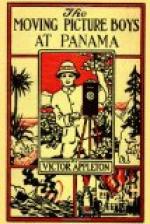In a short time they were moving away from the pier, up the harbor and toward the wonderful locks and dam that form the amazing features (aside from the Culebra Cut) of the great Canal.
“Better get our cameras ready; hadn’t we, Blake?” suggested Joe.
“I think so,” agreed his chum. “Now, Mr. Alcando, if you want to pick up any points, you can watch us. A little later we’ll let you grind the crank yourself.”
I might explain, briefly, that moving pictures are taken not by pressing a switch, or a rubber bulb, such as that which works a camera shutter, but by the continuous action of a crank, or handle, attached to the camera. Pressing a bulb does well enough for taking a single picture, but when a series, on a long celluloid strip, are needed, as in the case for the “movies,” an entirely different arrangement becomes absolutely necessary.
The sensitive celluloid film must move continuously, in a somewhat jerky fashion, inside the dark light-tight camera, and behind the lens. As each picture, showing some particular motion, is taken, the film halts for the briefest space of time, and then goes on, to be wound up in the box, and a new portion brought before the lens for exposure.
All this the crank does automatically, opening and closing the shutter, moving the film and all that is necessary.
I wish I had space, not only to tell you more of how moving pictures are made, but much about the Panama Canal. As to the former—the pictures—in other books of this series I have done my best to give you a brief account of that wonderful industry.
Now as to the Canal—it is such a vast undertaking and subject that only in a great volume could I hope to do it justice. And in a story (such as this is intended to be), I am afraid you would think I was trying to give you pretty dry reading if I gave you too many facts and figures.
Of course many of you have read of the Canal in the newspapers—the controversy over the choice of the route, the discussion as to whether a sea level or a lock canal was best, and many other points, especially whether the Gatun Dam would be able to hold back the waters of the Chagres River.
With all that I have nothing to do in this book, but I hope you will pardon just a little reference to the Canal, especially the lock features, since Joe and Blake had a part in at least filming those wonderful structures.
You know there are two kinds of canals, those on the level, which are merely big over-grown ditches, and those which have to go over hills and through low valleys.
There are two ways of getting a canal over a hill. One is to build it and let the water in to the foot of the hill, and then to raise vessels over, the crest of the hill, and down the other side to where the canal again starts, by means of inclined planes, or marine railways.
The other method is by “locks,” as they are called. That is, there are built a series of basins with powerful, water-tight gates dividing them. Boys who live along canals well know how locks work.




